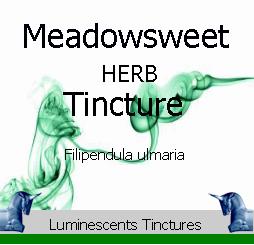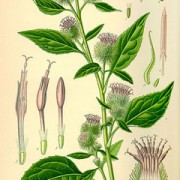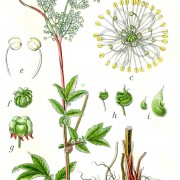Filipendula ulmaria, from which this Meadowsweet Tincture is derived, is also known as Queen of the Meadow, Pride of the Meadow, Meadow-Wort, Meadwort, and Bridewort and is a perennial herb in the family Rosaceae, which grows in damp meadows. It is native throughout most of Europe and Western Asia although it has been successfully introduced and naturalized in North America.
Meadowsweet has delicate, graceful, creamy-white flowers clustered close together in handsome irregularly-branched cymes, having a very strong, sweet smell. They flower from June to early September.
Uses of Meadowsweet Tincture:-
Tincture from the whole herb possesses a pleasant taste and flavour, the green parts having a similar aromatic character to the flowers, leading to the use of the plant to strew on floors to give the rooms a pleasant aroma, and its use to flavour wine, beer and many vinegars which the tincture makes readily available.
The flowers can be added to stewed fruit and jams, giving them a subtle almond flavour.
Meadowsweet was regarded as sacred by the Druids. It has many medicinal properties. The whole plant is a traditional remedy for an acidic stomach and the fresh root is often used in homeopathic preparations. It is effective on its own the treatment of diarrhoea. The flowers, when made into a tea, are a comfort to flu victims. Dried, the flowers make a lovely potpourris.
In 1897 Felix Hoffmann created a synthetically altered version of salicin, derived from the species, which caused less digestive upset than pure salicylic acid. The new drug, formally Acetylsalicylic acid, was named aspirin by Hoffman’s employer Bayer AG after the old botannical name for Meadowsweet, Spirea ulmaria. This gave rise to the hugely important class of drugs known as NonSteroidal AntiInflammatory Drugs, or NSAIDs.
A natural black dye can be obtained from the roots by using a copper mordant.
History of Meadowsweet :-
White-flowered Meadowsweet has been found with the cremated remains of three people and at least one animal in a Bronze Age cairn at Fan Foel, Carmarthenshire.
Similar finds have also been found inside a Beaker burial from Ashgrove, Fife and a vessel from North Mains, Strathallan. These could possibly indicate honey-based mead or flavoured ale, or alternatively might suggest the plant being placed on the grave as a scented flower.
In Welsh Mythology, Gwydion and Math created a woman out of oak blossom, broom, and meadowsweet and named her Blodeuwedd (“flower face”).
It is known by many other names, and in Chaucer’s The Knight’s Tale it is known as Meadwort and was one of the ingredients in a drink caled “save.” It was also known as Bridewort, because it was strewn in churches for festivals and weddings , often made into bridal garlands. In Europe, it took its name “queen of the meadow” for the way it can dominate a low-lying, damp meadow.
In the 16th century, when it was customary to strew floors with rushes and herbs (both to give warmth underfoot and to overcome smells and infections), it was a favourite of Queen Elizabeth I. She desired it above all other herbs in her chambers.







